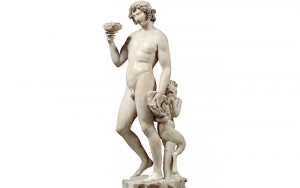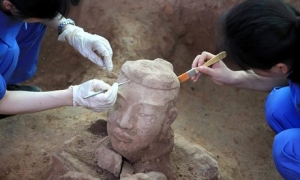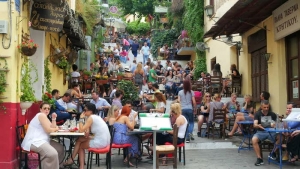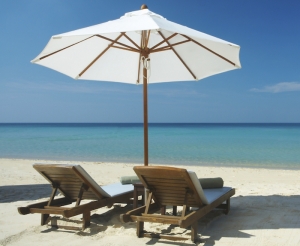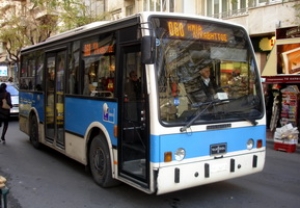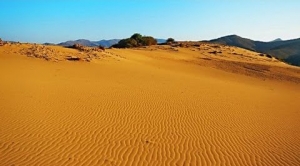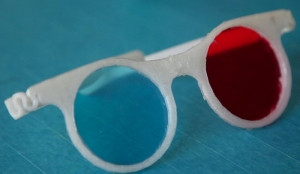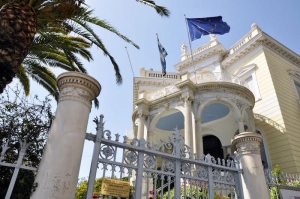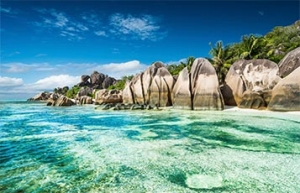ABOUT US
XpatAthens
Thursday, 27 October 2016 07:00
Dionysus - God Of Wine And Ecstasy
Worshipped in temples, theaters, public festivals and private parties, Dionysus brought joy and relief to ancient Greek life.
Dionysus, the ancient Greek god of wine, often seems a familiar, likable figure, perhaps because wine and its associated rituals are such a characteristic ingredient of our own modern-day existence. Like other deities, Dionysus appears in human form and is credited with divine powers; yet thanks to his love of drinking, dancing, music and uninhibited merry-making with free-spirited friends, he offers an even more evocative reflection of the human condition and represented a favorite figure in ancient Greek religion and art.
Dionysus was the son of Zeus, ruler of the Olympian gods, and Semele, a Theban princess and daughter of King Cadmus. After his mother was tricked and killed by Hera (Zeus’ vengeful wife), Dionysus was rescued from Semele’s womb by his father and implanted in his thigh. On his son’s birth, Zeus placed Dionysus in the care of nymphs who inhabited the mythical mountain Nysa – variously located by mythologists somewhere to the east, perhaps even in distant India. As he matured, Dionysus took up wandering from land to land, accompanied by an entourage that included his tutor, Silenus, satyrs, maenads and the lustful god Pan, a human-like figure with the horns and legs of a goat.
Dionysus was considered a latecomer to the Greek pantheon and an exotic, somewhat foreign divinity.
Athenians honored Dionysus in a series of annual festivals, celebrated at three key spots sacred to the god: the “Lenaeum” (location unknown); the sanctuary “In the Marshes” (location unknown); and at his temple on the south slope of the Acropolis, adjacent to the Theater of Dionysus.
To read this article in full, please visit: Greece Is
Published in
Greek Language & Culture
Tagged under
Thursday, 27 October 2016 07:00
Ancient Greeks May Have Inspired China's Terracotta Army
Greek craft workers may have helped inspire the most famous Chinese sculptures ever made – the 8,000 warriors of the Terracotta Army who have been watching over the tomb of the first emperor of China for more than 2,000 years.
Archaeologists and historians working on the warriors say they now believe that the figures’ startlingly lifelike appearance could have been influenced by the arrival in China of ancient Greek sculptures, and even that Greek sculptors made their way there to teach their designs.
Li Xiuzhen, a senior archaeologist at the site says, “We now have evidence that close contact existed between the first emperor’s China and the west before the formal opening of the Silk Road. This is far earlier than we formerly thought,” she said. “We now think the Terracotta Army, the acrobats and the bronze sculptures found on site, have been inspired by ancient Greek sculptures and art.”
To read this article in full, please visit: The Guardian
Published in
Greece In The News
Tagged under
Wednesday, 26 October 2016 21:26
The Struggle Behind The Lens - Interview With Greek Filmmaker Takis Bardakos
On October 5, 2016 Athens From Beneath, an insightful documentary about Greece’s unemployed, will premiere in the U.S. at the New York City Greek Film Festival, an extraordinary feat for the man behind the lens Takis Bardakos, who directed, produced, and wrote the film while he too was struggling with his own economic crisis, one that left him and his family homeless and unemployed.
Takis Bardakos, 59, who has a quiet, gentle presence but an endearing strength behind his voice, would rather talk about the plight of his fellow Greeks than about his own struggles. The only way in is to discuss his passion for film, especially his new documentary that holds true for far too many Greeks.
“Even though I was unemployed [and had no cash flow], I decided to start filming,” says Takis. “I found myself one morning outside church in a middle-class area with wealthy people and saw more than 150 people with bowed heads, waiting patiently to receive food. I never expected that in a parish with well-to-do residents, there would be so many people who didn’t even have food to eat. I met my colleague, and he comes out with food for his family.”
“I have to do something about it,” he says about the “new poor” in Greece, a country not used to seeing homelessness. Athens From Beneath was Takis’ solution to the growing problem, a way to cultivate social awareness. “I saw people sleeping in ruins, many living under bridges, sleeping in abandoned cars, other people, sick, and sleeping in cardboard boxes to protect themselves from the cold. I saw many looking in the trash and decided to start shooting, without a budget, but determined to get to the end.”
To read this article in full, please visit: Greek TV
Published in
People
Tagged under
Tuesday, 03 October 2017 07:00
A Vibrant Autumn City
With summer all but a memory, I ventured out on this beautiful Sunday to find that, in fact, summer seems to have decided to stick around a while longer…
But sunny skies notwithstanding, the autumn headlines have been leaving me with a less-than-sunny disposition.
Torrential downpours and floods around Greece…
Provocative statements from the Turkish president about ‘unjust’ national borders…
An election in the US that is leaving most of us dumbfounded and disappointed…
Refugees continuing to make the perilous journey to a questionable future…
Conflict in the Middle East that doesn’t seem to end…
An economy here at home that actually seems to be getting worse…
A ‘black hole’ of leadership in all corners…
…and that was just Saturday!
Despite it all, Athens feels alive – seemingly more than ever. Sunday was jam-packed with locals and tourists around town, enjoying a sunny respite from the downpours of Saturday. It seems like the city is becoming a real ‘city break’ destination, filling up over the weekend with smiling visitors, a weekend getaway from other European cities. Packed tavernas, overflowing cafes, lineups at the sites – maybe I’m imagining this, but it seems to me that the start of autumn has brought a distinct buzz to the city. Of course, the headlines say something else – but who believes headlines anymore? (!)
And then there is the rock – the Acropolis - always present, always watching, as if it has seen it all before and nothing can shake its resolve. Maybe after all this is the real symbol of Athens, beyond the old marble, it’s the resolve and immovable strength of the city that has enabled it to endure centuries and civilizations – and the day’s headlines. Maybe, in the end, this is who we are.
And in case you want to contemplate all of these over a coffee or a cocktail, with a rooftop view of the ancient rock, here is a list of ‘don’t miss’ city centre bars that fit the bill…!!
The Zillers - Mitropoleos 54, 210 322 2277
Bios - Peiraios 84, 210 342 5335
A for Athens - Miaouli 2-4, Monastiraki, 210 324 4244
Loukoumi - Abyssinias Square 3, Monastiraki, 210 323 4814
Couleur Locale - Normanou 3, Monastiraki, 216 700 4917
Chocolat - Apostolou Pavlou 27, Thiseio, 210 346 9077
La Vista Optimista - Ermou 95, Monastiraki, 210 325 0242
Until next week,
Jack
Published in
My Week In Athens
Tagged under
Tuesday, 25 October 2016 07:00
Sand And Water Play On The Beaches In Athens
Celeste from Family Goes Out agrees that the weather in Athens is mild enough year round to spend yours days playing on the beach! Here are just a few of her favorite Blue Flag beaches that are great not just for summer, but winter as well.
Schinias
This beach is located at a distance of 45 km from Athens at the North East side. In summer it can get very busy in the weekends with many young people and music but during the weekdays and off season this beach is one of my favorites. A long stretch of sandy beach in the Marathon Bay, clean water, organized and surrounded by many watersports centres in case your children are old enough.
Markopoulo – Avlaki Beach
This beach gets very crowded in summer and weekends but is ideal in autumn. It is organized with umbrellas, chairs, showers and snacks. At a 100 meter distance from Avlaki is Panorama beach, not organized but very good for families.
Varkiza
Varkiza is nice town to visit during a family excursion all year round. There are many taverns and playgrounds and the beach is sandy with volleyball courts, water games and open play areas. My favorite beach for families in Varkiza is Yabanaki beach. Varkiza is a small town and one of the most developed and popular areas in the southern suburbs, quite lively during the summer season.
To read this article in full, please visit: Family Goes Out
To read this article in full, please visit: Family Goes Out
Published in
Kids Life
Tagged under
Tuesday, 25 October 2016 07:00
New Bus Line 123 Saronida To Anavissos
In response to the requests of the residents in the Municipality of Saronikos and also in regard to the proper functioning of the Tourism School of Anavissos, OASA has formed a new circular bus line 123 from Saronida to Anavissos.
The buses will run every 35 minutes and will serve people going to and from Athens, residents of the wider area of Anavissos - Palaia Fokaia, and students that study at Anavissos School. This is in combination with the existing 122 line from Elliniko Metro station to Saronida.
The route of the new circular bus line 123 will pass from Saronida Avenue, Athinon-Souniou Avenue, Lakas Avenue and Karamanlis Avenue, while it will be stopping at the School of Tourism. For the convenience of passengers, OASA has established a total of 20 new bus stops in addition to the five stops that already exist.
You may see the full route here.
Originally posted on Drive & Travel.
Translated by XpatAthens
Published in
Local News
Tagged under
Monday, 24 October 2016 07:00
Lemnos - Home To Greece’s Unique Desert
Lemnos is a magical place. A small island in the northern Aegean, the place where the three continents of Europe, Asia and Africa meet. Another reason why Lemnos is so special is that according to several people the island is the home of the only European desert.
People who have not visited the beautiful Greek island of Lemnos may think that it is a place of exile, a place resembling the moonscape, but that is only because they had not had a chance to explore the majestic island.
On the north side of Lemnos, in an area called Gomati, visitors have the chance to witness a unique and unexpected sight, a small desert. The 7 hectare area is located away from the sea full and it’s full of sand and dunes constantly changing shape, just like in the Sahara desert, depending on the direction of the wind.
The ever-changing terrain and landscape of the sand dunes accompanied by the deep-blue colors of the Aegean Sea make for an unforgettable sight.
To read this article in full, please visit: Greek Reporter
To read this article in full, please visit: Greek Reporter
Published in
Travel Greece
Tagged under
Monday, 24 October 2016 07:00
The New Raw - Greek Design Workshop Rethinks Plastic Waste
The New Raw is a design workshop in Greece that upcycles plastic waste and gives it a new life. The two founders got the idea after seeing too much plastic not being used so they came up with the idea to turn the waste into something unique and useful.
Please click HERE to watch the video and see what
The New Raw designs and creates!
Published in
Videos
Tagged under
Friday, 21 October 2016 23:27
Museum Of Cycladic Art In Athens
The Museum of Cycladic Art, is a great little gem museum in the hearth of Athens, housing one of the most important collections of Cycladic Art in the world, as well as an impressive collection of Ancient Greek and Cypriot Art. Founded in 1986, it showcases more than 3.000 artefacts, from the 4th millennium BC to the 6th century AD.
Today, in the galleries of the MCA the visitor can approach three major subjects: Cycladic Art (3200-2000BC), Cypriot Art (3900 BC – AD 500) and Ancient Greek Art (2000 BC – AD 395).
The Collection of the Museum of Cycladic Art, one of the largest worldwide, is a major attraction, as simple marble figurines depicting naked human figures fascinate the visitor with their simplicity and abstraction, elements that inspired artists of the 20th century, such as Brancusi, Modigliani, Giacometti, Hepworth και Moore.
Apart from archaeology, the temporary exhibitions of the MCA frequently focus on modern and contemporary art, aiming to introduce the public to important 20th century artists (Dali, Picasso, etc.) and explore the links between ancient cultures and modern artistic creation.
Interactive educational programs for schools, children and families, guided tours, temporary exhibitions –archaeological, modern and contemporary–, conferences and various events complete the museum’s cultural profile. The Cycladic Café and the recently renovated Museum Shop are open during visiting hours.
1st Floor - Cycladic Art
Cycladic culture flourished on the islands of the central Aegean during the Early Bronze Age (3rd millennium BC). The MCA collection is one of the most comprehensive collections of Cycladic antiquities worldwide, comprising an astonishing variety of marble figurines and vessels, bronze tools and weapons, as well as pottery from all phases of the Early Cycladic period.
2nd Floor - Ancient Greek Art: A History in Images
The birth of Greek art in the protohistoric Aegean, the development of Classical culture and its gradual dissemination all over the Mediterranean basin constitutes one of the most influential phenomena in the history of western civilization. The MCA holds a large collection of Ancient Greek Art with representative artifacts from all periods between the Middle Bronze Age (2nd millennium BC) to the very end of the Roman period (4th c. AD). The MCA collections of Ancient of Greek Art have been integrated into a single permanent exhibition, titled "Ancient Greek Art – A history in images", which includes approximately 350 objects.
3nd Floor: Cyprus- Aspects of Ancient Art and Culture
The Cypriot collection in the MCA (Th.N. Zintilis collection) is one of the most comprehensive collections of Cypriot antiquities in the world. It contains more than 800 objects that help visitors learn about the history of the island and its relations with other regions of the eastern Mediterranean from the 4th millennium BC to the Early Christian period (6th c. AD).
4th Floor: Daily Life in Antiquity
The Collection of the Museum of Cycladic Art, one of the largest worldwide, is a major attraction, as simple marble figurines depicting naked human figures fascinate the visitor with their simplicity and abstraction, elements that inspired artists of the 20th century, such as Brancusi, Modigliani, Giacometti, Hepworth και Moore.
Apart from archaeology, the temporary exhibitions of the MCA frequently focus on modern and contemporary art, aiming to introduce the public to important 20th century artists (Dali, Picasso, etc.) and explore the links between ancient cultures and modern artistic creation.
Interactive educational programs for schools, children and families, guided tours, temporary exhibitions –archaeological, modern and contemporary–, conferences and various events complete the museum’s cultural profile. The Cycladic Café and the recently renovated Museum Shop are open during visiting hours.
1st Floor - Cycladic Art
Cycladic culture flourished on the islands of the central Aegean during the Early Bronze Age (3rd millennium BC). The MCA collection is one of the most comprehensive collections of Cycladic antiquities worldwide, comprising an astonishing variety of marble figurines and vessels, bronze tools and weapons, as well as pottery from all phases of the Early Cycladic period.
2nd Floor - Ancient Greek Art: A History in Images
The birth of Greek art in the protohistoric Aegean, the development of Classical culture and its gradual dissemination all over the Mediterranean basin constitutes one of the most influential phenomena in the history of western civilization. The MCA holds a large collection of Ancient Greek Art with representative artifacts from all periods between the Middle Bronze Age (2nd millennium BC) to the very end of the Roman period (4th c. AD). The MCA collections of Ancient of Greek Art have been integrated into a single permanent exhibition, titled "Ancient Greek Art – A history in images", which includes approximately 350 objects.
3nd Floor: Cyprus- Aspects of Ancient Art and Culture
The Cypriot collection in the MCA (Th.N. Zintilis collection) is one of the most comprehensive collections of Cypriot antiquities in the world. It contains more than 800 objects that help visitors learn about the history of the island and its relations with other regions of the eastern Mediterranean from the 4th millennium BC to the Early Christian period (6th c. AD).
4th Floor: Daily Life in Antiquity
This permanent exhibition tries to transform our knowledge about daily life in antiquity (as provided by ancient texts and archaeological objects) into vivid images. Visitors are invited into a virtual tour in time and space: the tours starts from the world of the supernatual (gods) and the myth (heroes), goes through the realm of Eros, follows the activities of everyday women and men in their private and public life, explores their religious behaviour, and concludes with their attitudes against death and their beliefs about afterlife and the Underworld.
One hundred forty two objects - mostly dating to the Classical Hellenistic periods (5th-1st c. BC) - are grouped in nine separate units.
One hundred forty two objects - mostly dating to the Classical Hellenistic periods (5th-1st c. BC) - are grouped in nine separate units.
Published in
Museums & Sites
Tagged under
Wednesday, 19 October 2016 16:19
Qatar Airways Daily Seychelles Service To Open Up Holiday Haven To Travellers
Travellers can enjoy their tropical dream-come-true with direct daily service between Doha and Seychelles!
Qatar Airways will provide travellers with greater access to the idyllic white sand beaches and turquoise waters of the Seychelles with daily flights from Doha starting on 12 December 2016.
Travellers wishing to explore the beauty of the Seychelles – one of the world’s most popular tourist destinations in the Indian Ocean – will enjoy convenient flights and award-winning service when travelling with Qatar Airways.
Residents of the Seychelles will also benefit from the opportunity to connect to the airline’s network of more than 150 business and leisure destinations around the world via the airline’s hub in Doha. The airline’s expanding global reach and modern fleet will take travellers to exciting places across the globe including the airline’s latest destinations launched in 2016: Adelaide, Atlanta, Birmingham, Boston, Helsinki, Los Angeles, Marrakech, Pisa, Ras Al Khaimah, Sydney, Windhoek and Yerevan.
Qatar Airways Group Chief Executive, His Excellency Mr. Akbar Al Baker, said, “Over recent years Qatar Airways has seen significant growth, expanding its worldwide footprint to provide more opportunities for global leisure travellers to premium destinations such as the Seychelles. When travelling with Qatar Airways we ensure that our passengers’ dream holiday starts with an extraordinary journey on board, where they truly experience the warmth of Middle Eastern hospitality, world-class service, award-winning cuisine and in-flight entertainment.”
Seychelles Minister of Tourism and Culture, Mr. Alain St. Ange, said: “It gives me great pleasure to see Qatar Airways serving the Seychelles. Our partnership has always been a very positive one. I know that the airline is very popular with the local community and we all look forward to many more years of fruitful cooperation and increased tourism business to our shores.”
Seychelles Tourism Board, Chief Executive Officer, Ms. Sherin Naiken, added, “The Seychelles Tourism Board is very happy to welcome Qatar Airways. We are looking forward to building a partnership with the airline that will foster the development of tourism and growth of local business.”
Passengers flying to the Seychelles from any of Qatar Airways' more than 150 destinations around the world will enjoy a quick and convenient transfer at the airline’s state-of-the-art hub Hamad International Airport. Offering more than 100 retail and dining options and unique services such as a 25-metre swimming pool, hotel and spa, designed exclusively for those in transit, the airport is sure to further enhance the passengers’ overall travel experience.
Qatar Airways, the national airline of the State of Qatar, is one of the fastest growing airlines operating one of the youngest fleets in the world. Now in its 19th year of operations, the airline has a modern fleet of 190 aircraft flying to more than 150 key business and leisure destinations across six continents.
About Qatar Airways
Qatar Airways, the national carrier of the State of Qatar, is one of the fastest growing airlines operating one of the youngest fleets in the world. Now in its 19th year of operations, Qatar Airways has a modern fleet of 190 aircraft flying to more than 150 key business and leisure destinations across six continents.
A multiple award-winning airline, Qatar Airways was awarded World's Best Business Class, Best Business Class Airline Lounge, and Best Airline Staff Service in the Middle East at the prestigious 2016 World Airline Awards managed by international air transport rating organisation Skytrax.
Qatar Airways is a member of the oneworld global alliance. The award-winning alliance was named the World’s Best Airline Alliance 2015 by Skytrax for the third year running. Qatar Airways was the first Gulf carrier to join global airline alliance, oneworld, enabling its passengers to benefit from more than 1,000 airports in more than 150 countries, with 14,250 daily departures.
For more information, please visit their website: Qatar Airways
Published in
International Travel
Tagged under

